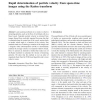Free Online Productivity Tools
i2Speak
i2Symbol
i2OCR
iTex2Img
iWeb2Print
iWeb2Shot
i2Type
iPdf2Split
iPdf2Merge
i2Bopomofo
i2Arabic
i2Style
i2Image
i2PDF
iLatex2Rtf
Sci2ools
JCNS
2010
2010
Rapid determination of particle velocity from space-time images using the Radon transform
Laser-scanning methods are a means to observe streaming particles, such as the flow of red blood cells in a blood vessel. Typically, particle velocity is extracted from images formed from cyclically repeated line-scan data that is obtained along the center-line of the vessel; motion leads to streaks whose angle is a function of the velocity. Past methods made use of shearing or rotation of the images and a Singular Value Decomposition (SVD) to automatically estimate the average velocity in a temporal window of data. Here we present an alternative method that makes use of the Radon transform to calculate the velocity of streaming particles. We show that this method is over an order of magnitude faster than the SVD-based algorithm and is more robust to noise. Keywords Automation . Blood flow. Brain . Kidney. Laser-scanning microscopy. Line-scan . tumor
| Added | 28 Jan 2011 |
| Updated | 28 Jan 2011 |
| Type | Journal |
| Year | 2010 |
| Where | JCNS |
| Authors | Patrick J. Drew, Pablo Blinder, Gert Cauwenberghs, Andy Y. Shih, David Kleinfeld |
Comments (0)

